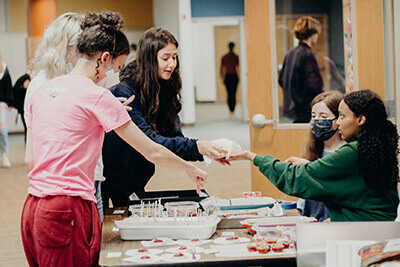April 18, 2022
 At home, you teach your children values. Shouldn’t their school do the same? Respect and integrity are integral components of the Mounds Park Academy mission, and character development is woven into the MPA experience. Rooted in the idea that the human character is malleable and children are exceptionally capable of positively impacting the world, character has been taught as one part of the whole child at Mounds Park Academy since 1982.
At home, you teach your children values. Shouldn’t their school do the same? Respect and integrity are integral components of the Mounds Park Academy mission, and character development is woven into the MPA experience. Rooted in the idea that the human character is malleable and children are exceptionally capable of positively impacting the world, character has been taught as one part of the whole child at Mounds Park Academy since 1982.
Respect, integrity, and global responsibility are as central to the mission of the school as intellectual ambition and effective communication. Varied, creative, and always evolving, how each teacher approaches character education is as unique as their own DNA. Teacher autonomy applies to all disciplines at MPA and is highly valued by teachers and administrators alike. It relies on mutual trust and is based on the idea that teachers are professionals who know their students best.
When the desire for formal character education during the early, foundational years of MPA rose to the surface, in true MPA fashion, leadership turned to our in-house experts—teachers. A committee composed solely of teachers was formed to establish CHAMP, a cohesive program with a strong academic foundation. The key components of CHAMP (Character Happens At Mounds Park) still hold true today: a partnership between home and school is essential; character education is embedded into the full curricular and extracurricular experience; adults intentionally model the character we expect; strong character and positive behavioral choices should be practiced; and ongoing evaluation and evolution are needed to ensure the program’s viability. Seven character traits of the program were identified—friendship, compassion, respect, self-control, responsibility, cooperation, integrity—with inclusiveness, courage, and mindfulness being added in recent years.
With few limits or parameters, the model was creative, unique, and engaging. “Because it was an organic program that we created to meet the needs of our school, teachers really engaged with it and bought into the whole idea. If you walk into a classroom today, you can hear someone refer to ‘CHAMP behavior.’ They are using it in their classrooms and it is being reinforced every single day,” says Lower School director and former teacher Renee Wright. The program they designed was so successful, so embraced, and so appreciated that it has stood the test of time, impacted hundreds, if not thousands of lives, and continues to grow and evolve today.
Character Through Culture
Guided by the idea that character education should be integrated into every aspect of the curriculum, the CHAMP program created a common and shared language that is embedded into every interaction and subject area. This means that the term CHAMP—or, more likely, one of the character traits it espouses—is just as likely to be heard in a gym class or math class as it is to be heard in a technology class or music class.
Ms. Espeland, a music teacher at MPA for nearly 30 years, shares what that might look like in her classroom. “An integral part of the Lower School music education experience is learning to work in a group. Students sing, dance, and play instruments together as a musical ensemble. Think of the high level of cooperation and self-control required to be in motion as everyone around you is in motion, too! Playing in ensemble requires that everyone is synchronized on the same steady beat as they play their part. Never a race, music provides both the framework for and challenge of working together.”
In first through fourth grades, digital citizenship is taught based on Common Sense Media’s curriculum with the goal of fostering respectful and engaged online citizens. They discuss the responsibility and impact of words that are shared online versus words that are spoken face to face. The incredible importance of exhibiting CHAMP behavior both in person and behind a screen is included in that conversation as well. Online safety, rules for interactions, evaluating fact vs. fiction, and crediting others’ work are all topics that our students discuss and practice in increasingly complex ways throughout Lower School and beyond.
In the Middle School, character education is woven into every facet of a student’s day. By challenging students to take risks and push themselves in a safe environment, MPA fosters a lifelong habit of ethical, active citizenship, as well as gives students the confidence to navigate challenges. All Middle School students attend monthly character education assemblies, participate in small group discussions in advisory and other classes, and engage in self-reflection exercises and goal-setting activities. Students build an ePortfolio in which they demonstrate their growth and accomplishments in the nine pillars of character education–creativity, curiosity, perseverance, courage, gratitude, integrity, collaboration, communication, and respect–and eighth graders work with faculty mentors to shape a presentation that showcases their character strengths and reflects on their challenges.
The Upper School peer leaders also focus on these qualities during their monthly meetings with seventh and eighth grade students. As a result of this work, the MPA Middle School continues to score above the INDEX mean on the Mission Skills Assessment, particularly in the areas of creativity, curiosity, ethics, resilience, and life satisfaction.
 Character Through Advocacy
Character Through Advocacy
Another way CHAMP is embedded into the students’ curriculum is through service and service-learning projects. The most notable and long-standing is the Birthday Box project, which provides celebration kits to children at a local homeless residence, Emma’s Place.
Mary Beggin, former second grade teacher, brought this program to MPA when she came in 1998. It has changed and evolved over the years, but now second and first graders partner to organize it. “Students came up with the idea of bringing in coins they earn at home each day for one week: pennies on Monday, nickels on Tuesday, dimes on Wednesday, quarters on Thursday and dollar bills on Friday. The first and second grade teachers then use this money to purchase items for birthday boxes. Last year, Emma’s Place serves 60 children ranging in ages from 0 to 18 years, and we provide a box for each one,” explains Beggin.
Deeply embedded into the math curriculum, the change collected provides ample opportunities to identify and sort coins, estimate values, calculate values, and add it all together. “At this age they start realizing that it gives them joy to do things for others. We do it in big and small ways in second grade, from holding the door for others to writing weekly compliments to friends. It is amazing to see this grow over the course of the year and it increasingly becomes part of the fabric of who they are,” says second grade teacher Anne Scalia.
In addition to the support they give Middle School students, Upper School students continue to evolve their character traits through service, coming full circle from the work done in Lower School. As a graduation requirement, MPA Upper School students must volunteer in the community for a required number of hours, and they may choose an organization with a mission that is important to them. Seniors complete a Senior Service Project, which is the culmination of many years of service learning and understanding the importance of giving back. Many seniors also cultivate their character through projects in MPA’s Public Policy course. They choose a policy to research and represent, and Minnesota laws have been passed with the help of the diligent students. Examples of public policy projects have been support of Minnesota’s smoking ban, submission of a law prohibiting all cell phone use while operating a motor vehicle, and organization of a rally at the State Capitol to raise awareness of Minnesota’s weak anti-bullying laws.
Character Through Evolution
Each summer, a new volunteer CHAMP committee meets to re-energize the program. They select a theme for the school year and other elements to keep it fresh and interesting for students.
For example, when “courage” was added as a trait, each student identified a courage goal each trimester and they recognize each other for demonstrating courage on the courage tree. “This might seem like a little thing to us, but it’s a really big thing to the students,” says Wright. Come spring, students will work in the Peace Garden, adding stump seats engraved with the traits to engage in kinesthetic learning.
When asked what aspect of CHAMP makes Wright most proud she shares, “When I go into classrooms to talk about challenging topics, the comments that the students make come directly from CHAMP in heartfelt and genuine ways. They aren’t thinking about CHAMP in that moment, but what they are saying, and how they are describing their thoughts and feelings, come from what we’re teaching through the program. The students articulate it in their own words and directly from their hearts.”